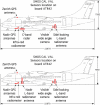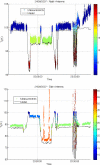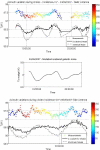CAROLS: a new airborne L-band radiometer for ocean surface and land observations
- PMID: 22346599
- PMCID: PMC3274072
- DOI: 10.3390/s110100719
CAROLS: a new airborne L-band radiometer for ocean surface and land observations
Abstract
The "Cooperative Airborne Radiometer for Ocean and Land Studies" (CAROLS) L-Band radiometer was designed and built as a copy of the EMIRAD II radiometer constructed by the Technical University of Denmark team. It is a fully polarimetric and direct sampling correlation radiometer. It is installed on board a dedicated French ATR42 research aircraft, in conjunction with other airborne instruments (C-Band scatterometer-STORM, the GOLD-RTR GPS system, the infrared CIMEL radiometer and a visible wavelength camera). Following initial laboratory qualifications, three airborne campaigns involving 21 flights were carried out over South West France, the Valencia site and the Bay of Biscay (Atlantic Ocean) in 2007, 2008 and 2009, in coordination with in situ field campaigns. In order to validate the CAROLS data, various aircraft flight patterns and maneuvers were implemented, including straight horizontal flights, circular flights, wing and nose wags over the ocean. Analysis of the first two campaigns in 2007 and 2008 leads us to improve the CAROLS radiometer regarding isolation between channels and filter bandwidth. After implementation of these improvements, results show that the instrument is conforming to specification and is a useful tool for Soil Moisture and Ocean Salinity (SMOS) satellite validation as well as for specific studies on surface soil moisture or ocean salinity.
Keywords: CAROLS; L band; SMOS; ocean salinity; radiometer; soil moisture.
Figures
















References
-
- Ulaby F.T., Moore R.K., Fung A.K. Microwave Remote Sensing. Artech House; Norwood, MA, USA: 1981.
-
- Skou N. Microwave Radiometer Systems: Design and Analysis. Artech House; Norwood, MA, USA: 1989.
-
- Le Vine D.M., Griffis A.J., Swift C.T., Jackson T.J. ESTAR: A Synthetic Aperture Microwave Radiometer for Remote sensing Applications. Proc. IEEE. 1994;82:1787–1801.
-
- Wilson W.J., Yueh S.H., Dinardo S.J., Chazanoff S.L., Kitiyakara A., Li K.F., Rahmat-Samii Y. Passive Active L- and S-Band (PALS) Microwave Sensor for Ocean Salinity and Soil Moisture Measurements. IEEE Trans. Geosci. Remote Sens. 2001;39:1039–1048.
-
- Lemaître F., Poussière J.K., Kerr Y.H., Déjus M., Durbe R., De Rosnay P., Calvet J.C. Design and Test of the Ground based L-Band Radiometer for Estimating Water in Soils (LEWIS) IEEE Trans. Geosci. Remote Sens. 2004;42:1666–1676.
Publication types
LinkOut - more resources
Full Text Sources

